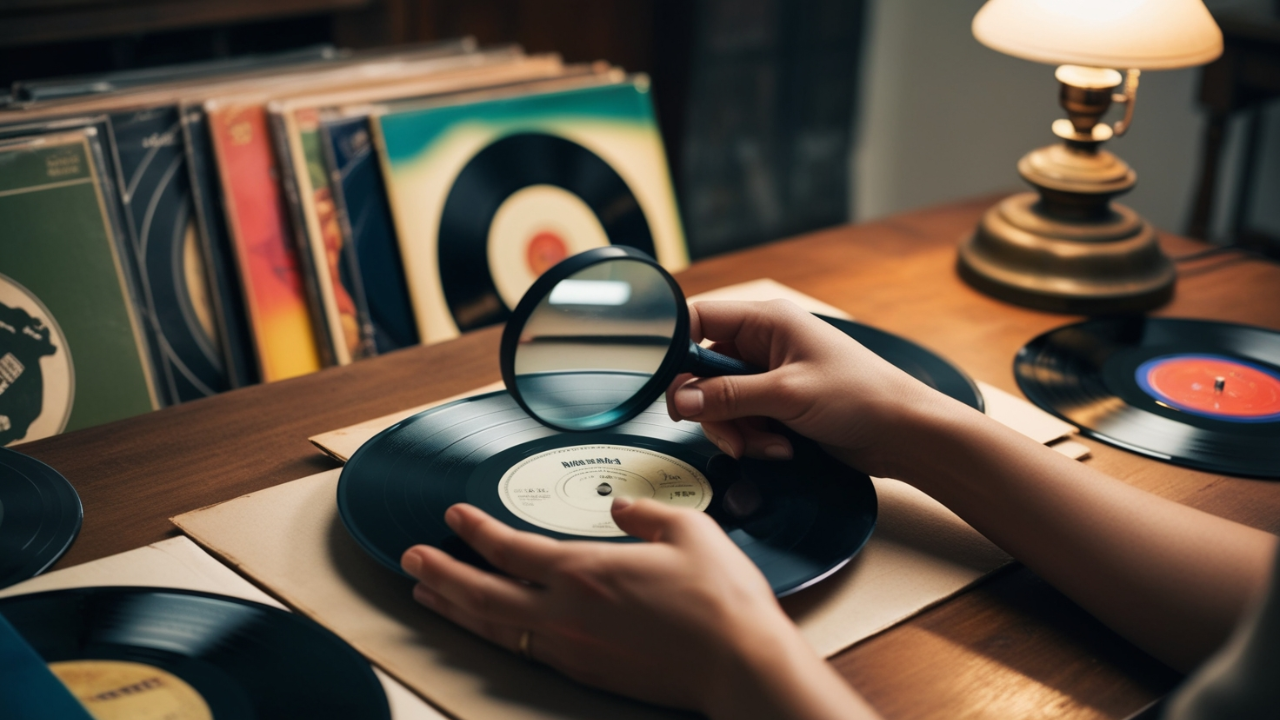Let me tell you a story. There I was, standing in a dusty old record shop, holding a worn Beatles album that looked like it had survived a small hurricane. Was it worth $10 or $1,000? The truth is, I had no clue! Vinyl record grading used to be my arch-nemesis—a mysterious art that seemed more complicated than quantum physics. Did you know that a single grade difference can change a record’s value by up to 50%? Crazy, right?!
When I first started collecting vinyl, I was that naive guy who thought a record was just, well, a record. I’d toss them around, stack them carelessly, and treat my precious music like yesterday’s newspaper. Big mistake! Learning about vinyl record grading was my wake-up call. It’s not just about collecting—it’s about preserving musical history, one groove at a time.
Contents
What is Vinyl Record Grading?
Alright, let’s break this down. Vinyl record grading is basically the process of evaluating a record’s physical condition. Think of it like a report card for your vinyl—except instead of grades determining your academic future, these grades determine your record’s value and collectibility.
I learned this the hard way. Once, I bought what I thought was an amazing rare pressing of a classic rock album. Looked great from a distance! But when I got home and really examined it? Total disaster. Scratches everywhere, warped edges, and sound quality that made my ears cry. That day, I realized grading isn’t just some fancy collector’s mumbo-jumbo—it’s crucial.
Grading matters for both collectors and sellers. For collectors, it helps you understand exactly what you’re buying. For sellers, it’s about being transparent and fair. Nobody wants to get scammed, and nobody wants to accidentally rip someone off.
The standards aren’t just arbitrary. They’re a universal language that vinyl enthusiasts speak. Whether you’re in New York or New Zealand, a “Near Mint” record means the same thing. It’s like the United Nations of music preservation!
The Standard Vinyl Grading Scale Explained
Let me introduce you to the vinyl grading bible. We’ve got a scale that ranges from Mint (practically perfect) to Poor (might as well use it as a frisbee). Here’s the breakdown:
Mint (M): Basically, this record looks like it just teleported from the pressing plant. Pristine, perfect, untouched. Sounds like a unicorn, right? These are super rare.
Near Mint (NM): This is the holy grail for most collectors. Maybe a teeny tiny imperfection, but nothing that affects play. I’ve seen maybe three of these in my entire collecting life.
Excellent (E): Some very minor signs of use. Might have a light surface mark, but plays beautifully. Most well-cared-for records fall here.
Very Good (VG): Now we’re talking real-world conditions. Some visible wear, maybe some light surface noise. Still totally playable and enjoyable.
Good (G): More significant wear. Might skip a bit, have more noticeable surface noise. Still has value for rare pressings.
Fair (F): Pretty beat up. Lots of surface noise, visible wear. Mostly for desperate collectors or completionists.
Poor (P): Basically a circular piece of noise and sadness. Avoid unless it’s mind-blowingly rare.
Pro tip? Always, ALWAYS look super close before buying. I once thought I was getting a deal on a “Good” condition record. Turns out, “Good” was a massive overstatement. Rookie mistake!
How to Inspect a Vinyl Record Like a Professional
Inspection is an art form, my friends. You need the right tools and the right technique. First up, get yourself a good light source. I’m talking bright, direct light that’ll reveal every microscopic imperfection.
I carry a few key tools in my vinyl detective kit:
- A bright LED flashlight
- White cotton gloves (because oils from your hands are record kryptonite)
- Magnifying glass
- Clean, soft microfiber cloth
When inspecting, hold the record at an angle under bright light. Look for:
- Surface scratches
- Warping
- Ring wear
- Dust and debris in the grooves
- Discoloration
Pro move? Always spin the record slowly, checking every inch. I once found a massive scratch hiding in plain sight by being patient and thorough.
Factors That Affect Vinyl Record Condition
Storage is everything. EVERYTHING. I cannot stress this enough. Improper storage is like sending your records to vinyl hell.
Keep records:
- Vertical (never stack horizontally)
- Away from direct sunlight
- In a climate-controlled environment
- In high-quality, acid-free inner sleeves
- Protected from dust and humidity
Environmental factors are brutal. Heat can warp records. Humidity can cause mold. Direct sunlight? Kiss that record goodbye. I learned these lessons through painful, expensive experiences.
Advanced Grading Considerations
Here’s where it gets nerdy—and I love it. Not all records are created equal. Original pressings? Different animal compared to reissues. Matrix numbers can tell you insane details about a record’s history.
Some collectors get crazy detailed. They’ll look at:
- Pressing location
- Original release date
- Manufacturing variations
- Label design
- Record weight
Pricing and Value Based on Record Condition
Condition dramatically impacts value. A mint condition rare record could be worth thousands. The same record in poor condition? Maybe enough for a fancy coffee.
Always cross-reference:
- Discogs marketplace
- eBay completed listings
- Specialized collector forums
Conclusion
Vinyl record grading isn’t just a skill—it’s a passion. Every scratch tells a story, every groove holds a memory. By understanding grading, you’re not just collecting records. You’re preserving musical history.
Ready to level up your vinyl game? Share your most incredible record finding story in the comments! Did you discover a hidden gem? Made a massive grading mistake? We want to hear all about it!
Keep spinning, keep collecting, and most importantly—respect the vinyl!

I am Kenneth Haney, an unyielding audiophile and an ardent collector of vinyl records. My love affair with vinyl started at a young age of 15. As a teenager, I found myself enchanted by the distinct warmth and depth that vinyl brought to music. Unlike digital music, vinyl records carry a tangibility, a piece of history, an art that exists far beyond the confines of an MP3 file.
